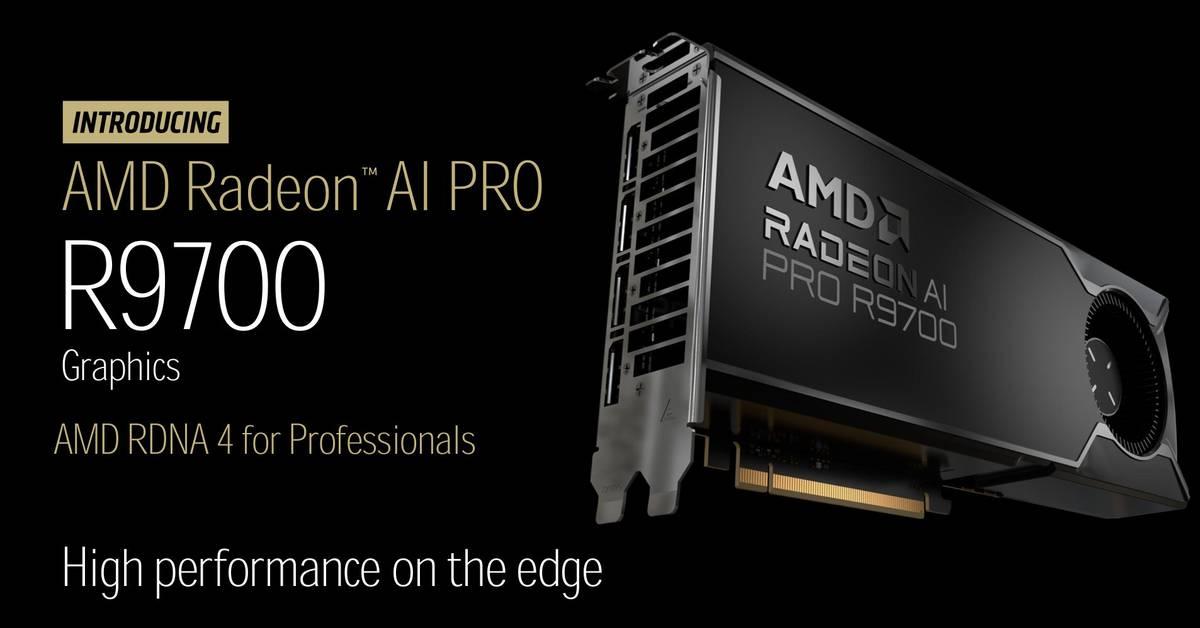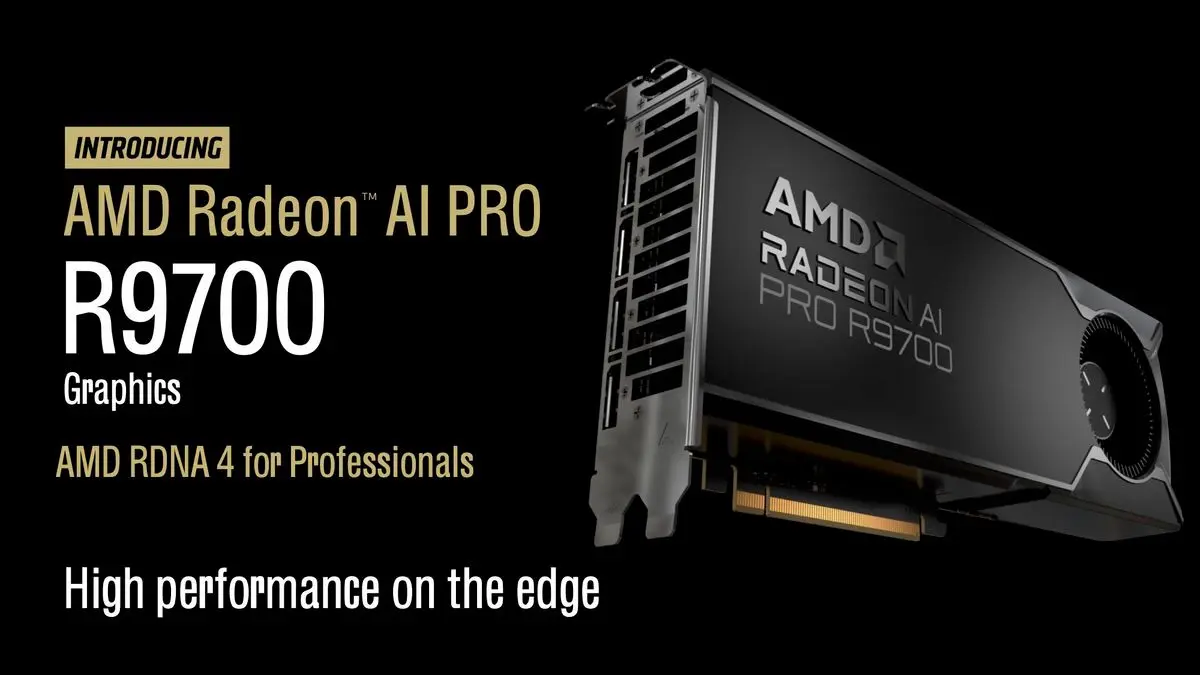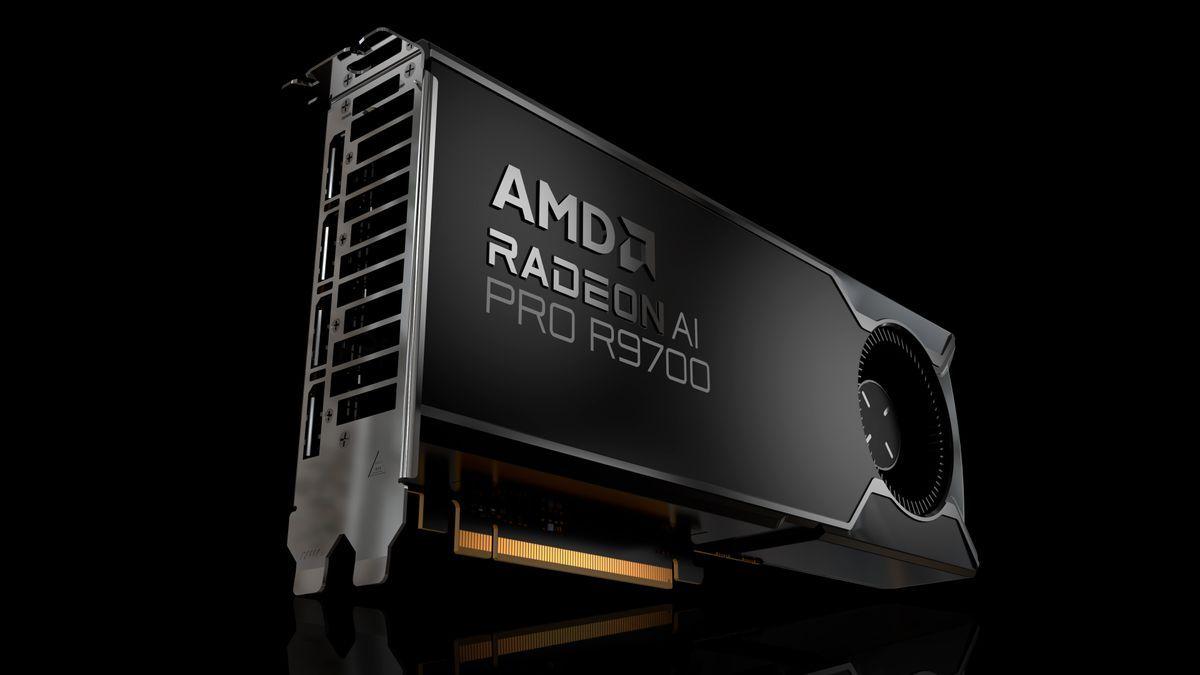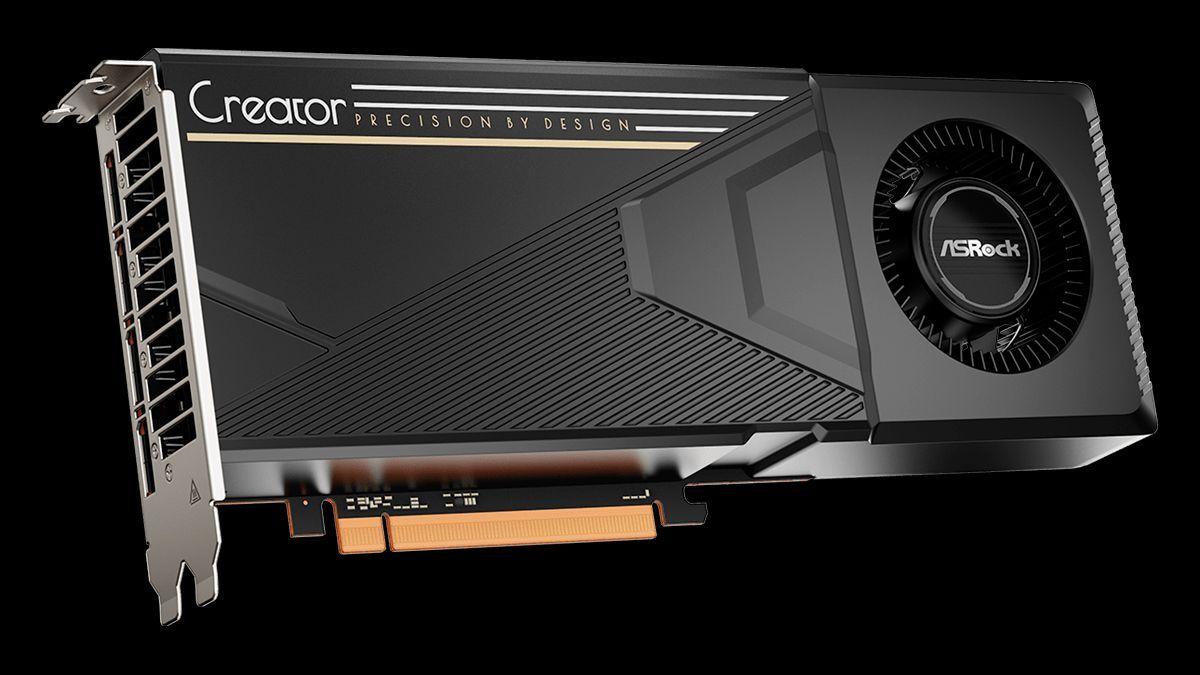AMD Launches Radeon AI PRO R9700: A Competitive AI-Focused GPU at $1,299
3 Sources
3 Sources
[1]
AMD Radeon AI PRO R9700 Linux Performance For Single & Dual GPU Benchmarks Review
Today the AMD Radeon AI PRO R9700 is officially shipping as the company's new RDNA4-based offering designed for AI workloads and priced at $1299+ USD. The AMD Radeon AI PRO R9700 offers 32GB of GDDR6 video memory and features 128 AI accelerators and rated for 96 TFLOPs peak half-precision compute, up to 1531 TOPS INT4 sparse, and has a 300 Watt TDP. Here are the initial benchmarks of the AMD Radeon AI PRO R9700 under Linux with ROCm 7.0 and testing both in single and dual R9700 graphics card configurations. After announcing the AMD Radeon AI PRO R9700 back at Computex, this AI-focused professional/workstation graphics card officially goes on sale today. The price starts out at $1299 USD for this 32GB, RDNA4-based graphics card. When announcing the Radeon AI PRO R9700, they advertised it as 2x the performance of the Radeon PRO W7800 graphics card. Compared to the prior flagship of the Radeon PRO W7900, it is cut-down with just 32GB of 256-bit GDDR6 compared to 48GB of 384-bit GDDR6 leading to lower vRAM bandwidth as well. The Radeon PRO W7900 also features 192 AI accelerators compared to 128 with the Radeon AI PRO R9700 as well as 4096 stream processors compared to 6144 on the W7900 and then 96 vs. 64 compute units, but this new product has the advantage of being based on RDNA 4 and PCI Express 5.0 and overall should perform better for AI workloads than the prior-generation RDNA3-based Radeon PRO W7000 series. The total board power is similar between the Radeon PRO W7900 at 295 Watts and the Radeon AI PRO R9700 at 300 Watts. The Radeon AI PRO R9700 GDDR6 memory is ECC capable -- interestingly only being wired up driver-side under Linux the specifications note. The display outputs on the Radeon AI PRO R9700 support DisplayPort 2.1a. Pricing on the AMD Radeon AI PRO R9700 is competitive with the NVIDIA RTX PRO 4000 Blackwell having 24GB of vRAM and retailing for $2499 USD. The AMD Radeon PRO W7900 had a launch price of $3999 USD and can still be found retailing for around $3.6k. So any price around $1299 USD is extremely competitive as about to be shown with our own benchmarks. AMD sent over two of the Radeon AI PRO R9700 graphics cards for review. With two being the likely popular configuration for the Radeon AI PRO R9700 in order to accommodate larger AI large language models (LLMs). The AMD Radeon AI PRO R9700 was working fine on the upstream Ubuntu 25.10 graphics driver stack and even Ubuntu 25.04.3 LTS software stack thanks to the mature open-source AMD RDNA4 support. Of course, the most common usage will be with the ROCm compute stack for handling GPU compute and AI workloads. Running ROCm 7.0.2 and the latest AMDGPU DKMS driver was the configuration for all of this launch-day AMD Radeon AI PRO R9700 testing under Ubuntu 24.04.3 LTS Linux. I am proud to say it was a very smooth experience using ROCm 7.0 with the Radeon AI PRO R9700 graphics cards. AMD continues making remarkable progress on the ROCm side with a lot of polishing over the past number of months, improved documentation, and the ROCm software just all-around being a lot more robust and reliable over the past year. With the AMD Radeon AI PRO R9700, ROCm 7.0.2 was working out great. For today's testing the focus was on the vLLM performance of the AMD Radeon AI PRO R9700 in both single and dual GPU configurations. The performance was compared to the prior generation of the AMD Radeon PRO W7900 graphics card. For a competitive analysis there was the NVIDIA RTX 6000 Ada Generation graphics card. Unfortunately, NVIDIA has yet to supply me any review samples of the RTX PRO Blackwell graphics cards which is why they aren't part of this comparison or the other articles on Phoronix. Even still, the RTX Ada Generation graphics cards continue enjoying robust availability. The NVIDIA RTX 4000 Ada Generation graphics card in my possession with its 20GB of vRAM wasn't able to handle the vLLM large language models being tested which is why that model was left out. The NVIDIA RTX 6000 Ada Generation graphics card is currently retailing for $5300+ USD. Let's see how the AMD Radeon AI PRO R9700 is looking for vLLM AI performance across different models while also looking at the power efficiency and performance-per-dollar.
[2]
AMD's new AI-focused graphics card could shake up the market
Nvidia continues to maintain a firm grasp on the entire GPU market, thanks to decades of innovation and some truly brilliant product launches. Those times are seemingly reserved for the dustbin of history as we see yet more expensive GPUs flood the market, making it a difficult time to be a PC gamer and upgrade your PC. The same goes for self-hosted AI workloads, where there aren't many options available outside of mainstream SKUs. Want the best large language model (LLM) performance? That'll be around $2,000 for the RTX 5090, if you're lucky. Enter AMD's all-new Radeon AI PRO R9700. As the name implies, this is a GPU built for AI workloads, such as self-hosted LLMs through Open WebUI. The cost? $1,299. Now, that sounds like a fair chunk of change for what is a specialized expansion card, but this thing isn't designed for running DOOM at ridiculous frames per second. It's got the internal grunt to smash through intensive inferencing with a whopping 32 GB of GDDR6 VRAM and a TDP of just 300 watts, putting it in competition with the RTX 5090 for those who wish to run AI models from home, and I'm excited for it! A new era for self-hosted LLMs More power with a lower TDP AMD's Radeon AI PRO R9700 is powered by the company's AMD RDNA 4 architecture, which is the same platform that launched the latest RX 9000 series gaming GPUs. We've got 64 Ray Accelerators, 128 AI Accelerators, 4,096 Steam Processors, 64 Compute Units, and a peak single precision performance score of around 47.8 TFLOPs (FP32 Vector). That's not too shabby at all, and it can boost fairly high, too, with a maximum boost frequency of 2,920 MHz. Specifications Radeon AI PRO 9700 GeForce RTX 5090 RTX PRO 5000 Architecture AMD RDNA 4 Nvidia Blackwell Nvidia Blackwell Memory 32 GB GDDR6 32 GB GDDR7 48 GB or 72 GB GDDR7 Memory Bandwidth 640 GB/s 1,800 GB/s 1,344 GB/s Ray Accelerators / RT Cores 64 170 110 AI Accelerators / Tensor Cores 128 680 440 Stream Processors / CUDA Cores 4,096 21,760 14,080 Compute Units 64 176 176 Boost Frequency 2,920 MHz 2,407 MHz 2,377 MHz Peak Pixel Fill-Rate 373.76 GP/s 423.6 GP/s 418.4 GP/s FP32 Vector (single) 47.8 TFLOPs 104.8 TFLOPs 66.94 TFLOPs FP16 Vector (half) 95.7 TFLOPs 209 TFLOPs 147.4 TFLOPs FP8 Matrix (8-bit) 383 TFLOPs 838 TFLOPs 542 TFLOPs Total Board Power (TBP) 300 W 600 W 300 W But what does all this jargon mean for running LLMs in your home lab? Good question! Nvidia traditionally has a much more mature stack for running AI and workstation tasks, but AMD is refining its offerings to remain competitive and catch up with its competitor. We've got explicit FP8, INT8, and INT4 support in ROCm tooling, and AMD is becoming a more viable option for quantized inference too. Comparing the 9700 against the 5090 shows Nvidia still has the upper hand, but at double the TBP. And because AMD's card has a total board power (TBP) rating of 300 watts, you can get away with a 750W power supply, making it a great choice for more compact server systems that don't have enterprise-grade hardware. You will still need to double-check the output of your PSU if you plan to use this inside a rack system. Where things get a little tricky is with the single 12V-2x6 connection. This does mean only a single cable is required, but ... just make sure it's plugged in properly. The AI PRO 9700 is a substantial upgrade over existing AMD cards, including the excellent AMD Radeon PRO W6800, with faster bandwidth, better compute support, and general performance improvements. The best part is we're only looking at a small 50W increase to the TBP. When can you buy one? We've already seen reports of retailers stocking the AMD Radeon AI PRO 9700 with differing price tags, but now we know precisely when you can fetch one and how much for. AMD will be releasing the gates on this new GPU come Monday, October 27, for $1,299. Whether this makes sense for your workstation or server depends on the workload and what you need most from such a card. If raw performance is all you care for, Nvidia may offer better options, but the AI PRO 9700 is an enticing GPU with its lower TDP and more open standards.
[3]
AMD Officially Prices Radeon AI PRO R9700 At $1299; Launch Date Announced
The most powerful RDNA 4 AI GPU will hit the shelves in a couple of days, and the official price tag confirms previous rumors. AMD has officially announced today that its most powerful RDNA 4-based workstation GPU, Radeon AI Pro R9700, will now be hitting the retail shelves, starting on 27th October. The GPU was unveiled at Computex this year, which was roughly five months ago. AMD has also revealed the official MSRP of the card, which confirms previous rumors. The card will officially cost $1299, and we have previously seen the ASRock Creator Radeon AI Pro R9700 listing for $1329 briefly on a retailer. The Radeon AI Pro R9700 will be available from AMD's board partners only since AMD won't be selling the reference design. Some board partners may sell the card via system integrators only, as we previously saw XFX mentioning on the official website. As far as the specs go, the Radeon AI Pro R9700 features the NAVI 48 die based on the RDNA 4 architecture. It's technically the same GPU as used on the flagship gaming Radeon RX 9070 XT, bringing 4096 Stream Processors, 128 ROPs, and the same number of RT Cores as well. However, the major difference is the VRAM capacity, as the Radeon AI Pro R9700 doubles the memory capacity in comparison to the RX 9070 XT. Since the R9700 is a workstation card, designed for intensive AI workloads, higher memory capacity is deployed on the card by introducing more memory modules. The card features 32 GB GDDR6 VRAM through a 256-bit memory bus, making it the cheapest 32 GB workstation GPU. Powered by AMD RDNA™ 4 architecture, the Radeon AI PRO R9700 enables medium to large AI models to run directly on local workstations. Combined with AMD ROCm™ open software support, the card accelerates large language models, diffusion models, and other compute-intensive workflows, bringing data-center-class efficiency to the desktop. - AMD AMD says it's two times faster vs W7800 in DeepSeek R1 and can handle LLMs and Text to Image AI workloads with ease. Previously, AMD has boasted about how advantageous its 32 GB VRAM is against high-end GPUs like GeForce RTX 5080, which ships with 16 GB VRAM only. Not just that, but the Radeon AI Pro R9700 also boasts Multi-GPU scalability via AMD ROCm, enabling high-throughput AI workloads on local workstations. It's compact, features only a dual-slot design, and has a blower-style cooler for efficient airflow, making it ideal for multiple GPU setups for expanded memory capacity.
Share
Share
Copy Link
AMD's new Radeon AI PRO R9700, based on RDNA4 architecture, offers high-performance AI capabilities at a competitive price point. The GPU is designed for AI workloads and competes with NVIDIA's offerings in the professional market.
AMD Unveils Radeon AI PRO R9700: A New Contender in AI GPU Market
AMD has officially launched its highly anticipated Radeon AI PRO R9700 graphics card, designed specifically for AI workloads. Set to hit the shelves on October 27, 2023, at a competitive price point of $1,299, this new offering aims to challenge NVIDIA's dominance in the AI GPU market
1
2
3
.
Source: XDA-Developers
Technical Specifications and Performance
The Radeon AI PRO R9700 is built on AMD's latest RDNA 4 architecture, boasting impressive specifications:
- 32GB of GDDR6 video memory
- 128 AI accelerators
- 4,096 Stream Processors
- 64 Compute Units
- Peak half-precision compute of 96 TFLOPs
- Maximum boost frequency of 2,920 MHz
- 300 Watt TDP
1
2

Source: Phoronix
AMD claims the R9700 offers twice the performance of their previous Radeon PRO W7800 graphics card. The new GPU supports explicit FP8, INT8, and INT4 in ROCm tooling, making it a viable option for quantized inference
2
.Competitive Positioning
Priced at $1,299, the Radeon AI PRO R9700 presents a compelling alternative to NVIDIA's offerings:
- NVIDIA RTX PRO 4000 Blackwell (24GB vRAM): $2,499
- NVIDIA RTX 6000 Ada Generation: $5,300+
The R9700's competitive pricing, combined with its 32GB of VRAM, positions it as an attractive option for professionals and researchers working with large language models (LLMs) and other AI workloads
1
2
.Power Efficiency and Versatility
One of the R9700's standout features is its power efficiency. With a total board power (TBP) of 300 watts, it consumes significantly less power than some competitors, such as the NVIDIA RTX 5090 which has a 600W TBP. This lower power consumption allows for more flexible integration into existing systems and potentially lower operating costs
2
.The card's compact, dual-slot design with a blower-style cooler makes it suitable for multi-GPU setups, enabling high-throughput AI workloads on local workstations
3
.Related Stories
Software Ecosystem and Compatibility
AMD has made significant strides in improving its software ecosystem:
- ROCm 7.0 support for enhanced AI and compute performance
- Smooth integration with Ubuntu 25.10 and even Ubuntu 25.04.3 LTS
- ECC-capable memory (currently only driver-side under Linux)
- DisplayPort 2.1a support
1
Market Impact and Future Outlook
The launch of the Radeon AI PRO R9700 signifies AMD's commitment to competing in the AI GPU market. By offering a high-performance, power-efficient option at a competitive price point, AMD is positioning itself to capture a larger share of the growing AI hardware market
2
3
.As the demand for AI-capable hardware continues to rise, particularly for self-hosted AI workloads and LLMs, the R9700 could potentially disrupt the market dominance currently held by NVIDIA. However, the success of AMD's offering will likely depend on continued software ecosystem development and adoption by key players in the AI industry
2
.References
Summarized by
Navi
[2]
Related Stories
Recent Highlights
1
AI Chatbots Sway Voters More Effectively Than Traditional Political Ads, New Studies Reveal
Science and Research

2
OpenAI declares code red as Google's Gemini 3 gains 200 million users in three months
Technology

3
Trump approves Nvidia H200 chip exports to China with 25% revenue cut, defying Senate concerns
Policy and Regulation








